Learning Stories
Through inquiry-based learning, we witness our learners’ journey unfold, each step marked by curiosity, exploration, and profound discovery. This documentation of learning stories shows their evolving understanding of the world, capturing their triumphs, insights and growth milestones.
In our journey inspired by the book, ‘The Things That I Love About Trees’, we embarked on a delightful exploration of nature’s artistry. This book invited us to observe the physical changes that trees undergo throughout the seasons, encouraging us to pause and truly see the world around us.
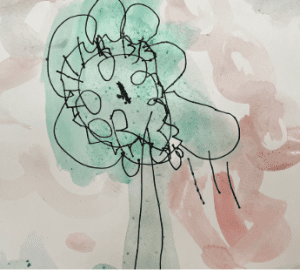
I saw the tree in summer has lots of leaves. I saw some clouds. The leaves change colour in autumn. Anupriya, 3.8

There are no leaves because the leaves are gone. It’s winter. In summer there are many leaves. In autumn the leaves change then they flew, flew far away and fall down. Annanya, 3.9
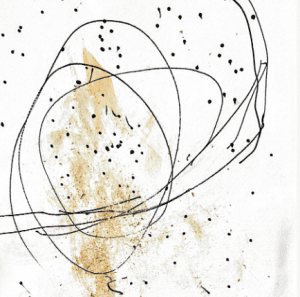
Lot of leaf falling. So many leaf falling down. Sai Pang, 3.4
As we ventured into the school garden, our curiosity flourished. We eagerly picked up items of interest and recorded our observations of the diverse plants, trees, fruits, flowers and leaves. Capturing our observations with observational drawings, we shared our findings with others.
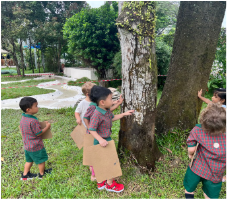
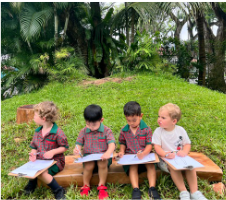
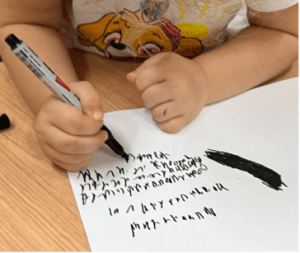
I look at flowers. I draw leaves and flowers here. Lily-Rose,3.6
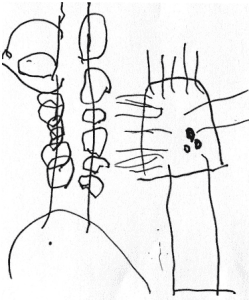
I see big tree and orange flower and I see mango tree. I draw so many mango.
Mushen, 4.2
Some of us began experimenting with flowers. As we crushed the flowers onto paper, we observed the vibrant marks they left behind. Excited by these discoveries, we shared our observations with one another, sparking a deeper interest in our exploration.
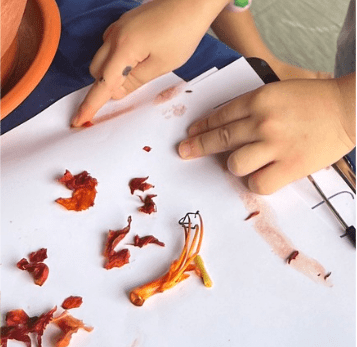
I crush it. It’s working. I drawing. I make orange with flowers. I make green with leaves. Mushen, 4.2
I put flowers on the paper. I pressed it and it put colour on the paper. Annanya, 3.9
I used a bit of red and yellow. I crushed it and the flower come on the paper. Thea, 3.7
Look, little green. I crush the leaf. I can smell it! Nicholas, 3.5
Experimenting, Observing
With the introduction of various tools and materials, such as rolling pins, mallets, mortar and pestles, mullers, hammers, clipboards, paper, and cloth our scientific discovery space became a vibrant hub for investigating nature prints.
Enthusiastically participating in this multi-sensory experience, we carefully analyzed our findings, observing the unique characteristics of each print. We evaluated and tested our ideas, identifying which flowers and leaves produced the most effective prints on paper and cloth as we crushed them using different tools.
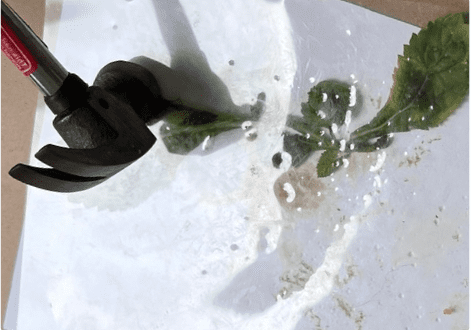
The big mallet works. The green is because I crush the leaves. I use a paper to press it down and I used some of these tools and I didn’t take it up so high. I only hit up and down, up and down. Thea, 3.7
Causation
In response to prompts, we generated new ideas and experimented with a variety of techniques, noticing the differences in the prints and marks left behind. As we demonstrated our growing understanding of shapes and patterns, we created and extended simple patterns using the flowers, deepening our exploration of nature’s artistry.
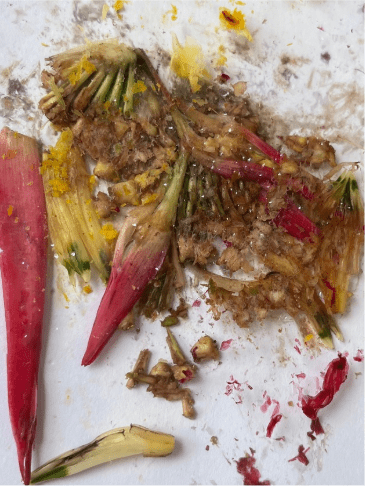
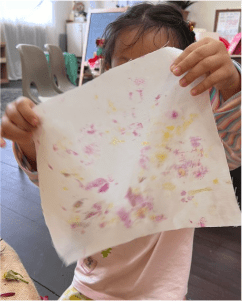
Because I crush it with hammer. I hit it so hard and I so strong. I press it so hard. I use that one (wooden muller). Lily-Rose, 3.6
I use that (metal hammer). It crush the flower, the colour come out. Sai Pang, 3.4
I hammer. Crush leaf, no colour because already dry. Hammer is good. I get more colour. Mushen, 4.2
Hypothesis
As we engaged our senses and honed our observational skills, we discovered that bright flowers produced stronger, more visible prints on the cloth. We also noticed that the fragrance of the flowers became more pronounced when we crushed them. However, as we continued to use the same flowers throughout the week, we found it increasingly difficult to create prints as effectively as we had before.
Reflecting on our experiences as thoughtful learners, we employed our critical thinking skills to draw simple conclusions based on our observations. Despite facing challenges, we demonstrated resilience and persevered to brainstorm ideas for extracting pigments from the flowers that were beginning to dry out.
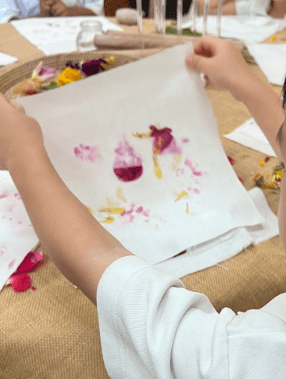
Need to crush it. Because the flower have no colour. Youzhen, 3.9
We can put a little water on it, and after some time the colour will come out. Anupriya, 3.8
I think we should crush the flowers and put them in the bottle with water. Thea, 3.7
Sharing findings
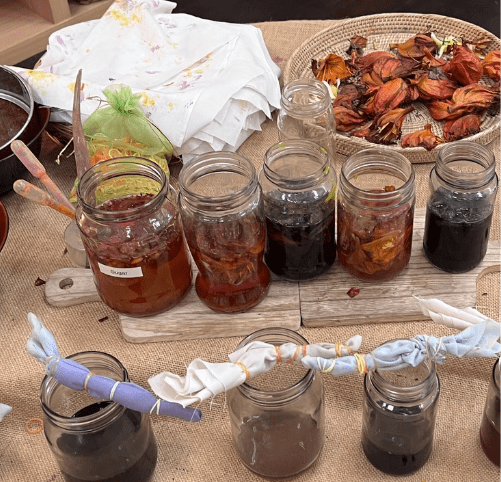
Demonstrating agency in our learning, we drew meaningful conclusions from our investigations. Taking initiative, we recorded our observations and findings through various mediums, including photos, videos, specimens, and mark-making.
To enhance our data collection, we utilised instruments, such as microscopes and iPads to capture images and videos. Additionally, we created observational drawings of the plants, trees, and flowers we used in our experiments. This diverse approach not only enriched our understanding but also fostered a deeper connection to our explorations in nature.
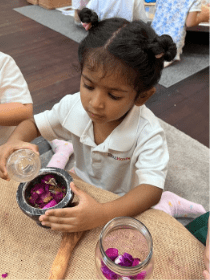
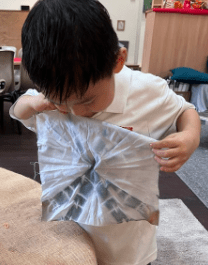
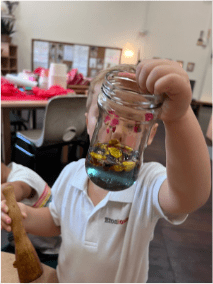
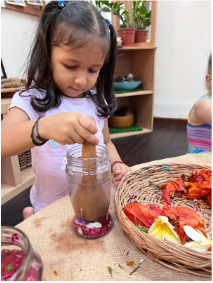
It is blue now. So much blue. Nicholas, 3.5
The water in my bottle is blue because I put the blue flowers. Jaidee, 3.5
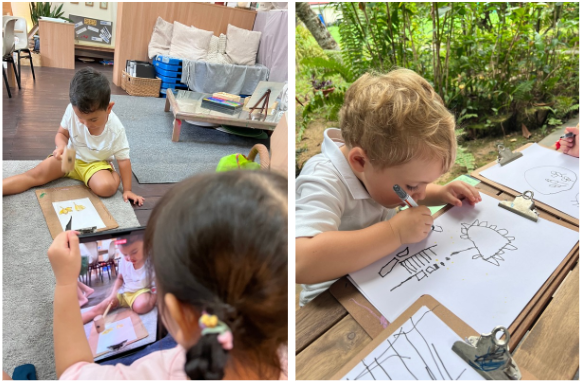
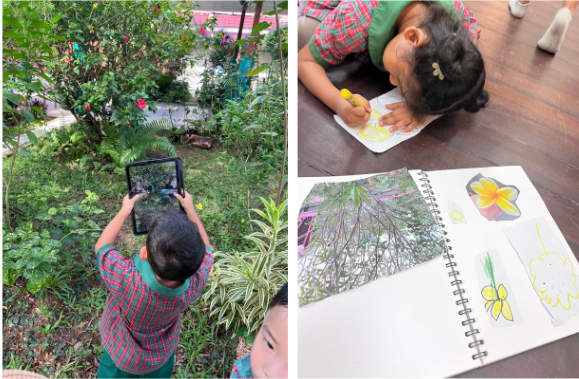
We delved into the use of maps as a means of locating the plants and trees involved in our experiments. To enrich our documentation process, we consulted books, deepening our inquiry into the concept of mapping. With our strengthened understanding of key concepts of form and perspective, we produced several drafts of our maps. Engaging in a cycle of review, we provided and received constructive feedback, which allowed us to refine our maps over time.
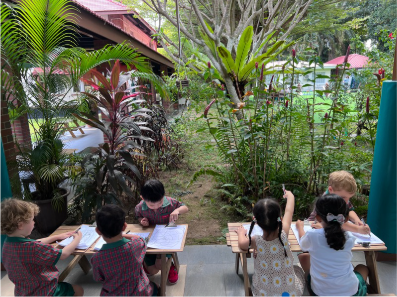
Collaborating closely, we brought together our observational drawings, specimens, maps, photos, and videos to create a comprehensive catalogue of our explorations and findings, highlighting the richness of our collective inquiry.
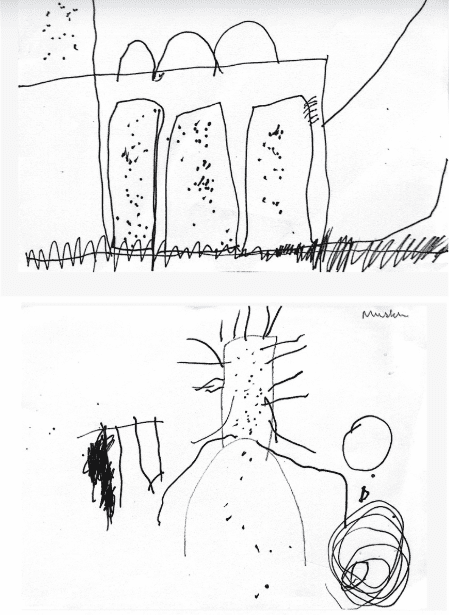
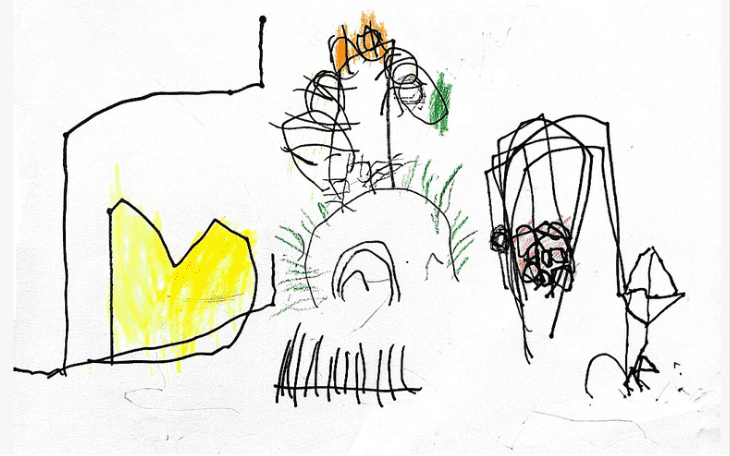
As we delved into the central idea, ‘Scientific investigations help us learn about the world’, we made meaningful connections to the line of inquiry, ’Reasons for exploration’. Through collaborative discussions, we shared what ‘exploration’ and ‘experimentation’ mean within the realm of science.
These reflections emerged from our recent experience in the sandpit, where we engaged in an experiment using hollow planks.
Our conversations highlighted our strong communication skills, as we effectively shared our thoughts and ideas, utilising relevant vocabulary to articulate our understanding. This exchange of information not only deepened our learning but also fostered a collaborative spirit among us.
Doing experiments is like art but it is not. We use different materials to make things.
Keyan, 5.4
Try and see what happens. Shivanshi, 5.8
It is like when we build a building with bricks and test it. Anavi, 6.1
Learn what new things do and you can go make it by yourself. Harry, 6
When we try something new. Lana, 5.7
One of our peers shared a book centered around experiments using Lego toys. Inspired by its content, we gathered to discuss the potential for exploring a variety of experiments, using the book as our guide. This sparked our curiosity and encouraged collaborative thinking as we envisioned our projects.
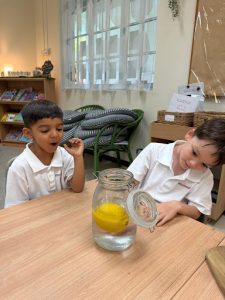
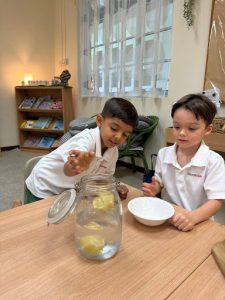
就是很像我们尝试不同的东西。像是⽤⽓球让⼀个⻋往前⾛ (We try new things, it is like we use to make balloon to make a car move) Yukun, 5.5
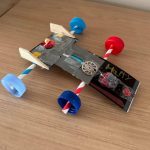
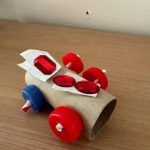
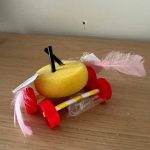
Our investigations made us curious about constructing a balloon-powered car. Collaborating with our group, we explored various recyclables, experimenting together to bring our ideas to life. This hands-on approach fostered creativity and teamwork as we designed and built our own balloon- powered cars.
The Process of Inquiry
While constructing the balloon-powered car, we stumbled upon the use of magnetic force to power cars and this lead us into investigating metallic versus non-metallic objects. Focusing on the key concept of perspective, we documented our findings with a clipboard and paper as we moved around the school, experimenting and testing varied surfaces and objects.
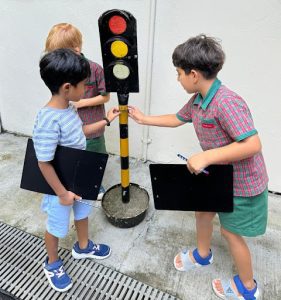
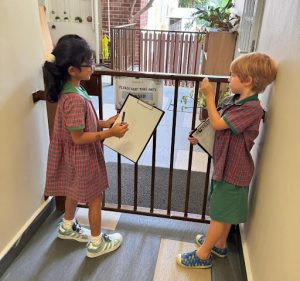
During the inquiry process, we encountered items that initially seemed metallic and magnetic but turned out to be non-magnetic. A notable example was the door handle of our classroom, which highlighted the importance of careful observation in distinguishing between true magnetic properties and surface appearances.
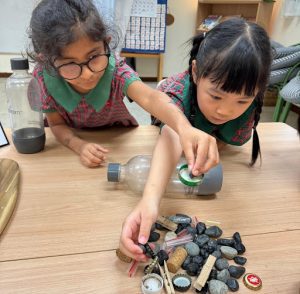
Maybe it is made of plastic that looks like metal. Keyan, 5.4
Yeah it is not! See Janelle, it does not stick! The magnet does not stick. Lana, 5.7
“How about this one?” Atharv, 6.3
No, they don’t stick! Keyan, 5.4
Which means it is not magnetic! Reeya, 6.0
Discovering magnetic properties
Subsequently, we delved deeper into the exploration of the world of magnets. While engaging with the magnets on the provocation table, we made the intriguing discovery that a magnet positioned beneath the table could move another magnet placed on top. This realisation led us to understand that the magnetic force can pass through certain objects and materials.
Curious about this phenomenon, we used various materials found in the classroom to conduct an experiment. Together, we researched which objects allowed the magnetic force to pass through, fostering our collaborative spirit and deepening our understanding of magnetism.
Oh my gosh, it can pass through this big board! Reeya,6
It can pass through my book and the magnet doesn’t fall! I wonder how many pages I can use until it stops getting magnetic. I think I should try ten more pages! Madison, 5.11
Our Actions
As we deepened our understanding of the characteristics of magnets, we engaged in a rich discussion about whether magnets retain their magnetic properties when submerged in water. Our curiosity led us to wonder if the magnetic force could persist and pass through water.
Inspired by our inquiries, we decided to test this notion through a hands-on experiment. This process allowed us to demonstrate our ability to collaborate, articulate our ideas, and set meaningful goals for our group interactions.
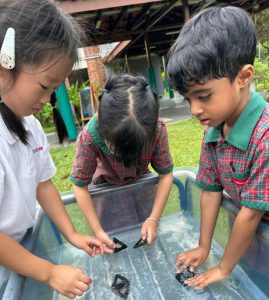
We can watch the video and the video will tell us how we can make our own magnet! Keyan, 5.4
How did it even do that? The nail is not attracted to the (stapler) bullets but after we rub the magnet on it, it just sticks to the bullets for a short while! We can’t do that for the other nail because it is too old and rusty. Madison, 5.11
As we reflected on our learning, we posed an intriguing question: “Can we make our own magnets?” We eagerly explored online resources and watched videos about the possibilities of magnet creation.
In our research, we discovered the stroke method, where a permanent magnet is used to stroke a metal object—like a metal bar or nail—to transfer magnetic force. Inspired by this newfound knowledge, we gathered the necessary materials and set out to conduct this experiment together, embodying the collaborative spirit of our learning community.


Arpit Marthur, Parent of Ameya, Nature Pre-School
We saw a very nurturing and thriving environment being offered by the teachers and other staff members. The teaching styles are tailored to cater for each child’s needs. Ameya is always happy going to school and surprises us with his learnings. Read more here
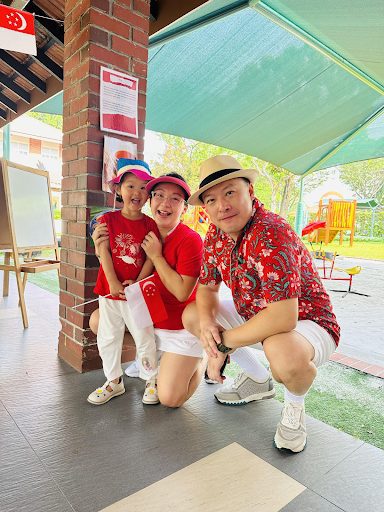

Wei Fang Lin, Parent of Joey, Nature Pre-School
We are very glad to see Joey’s new development in:
- Willing to share what she sees and what she hears everyday;
- Speaking English and Mandarin with different people effortlessly;
- Be willing to try new things and sports activities (such as walking to the subway station, riding a bicycle, etc.).


Prakash Maheswari, Parent of Kabir, Nature Pre-School
Moving countries was a big change for our son, but the environment was so welcoming and the teachers and staff so friendly and loving, that he settled in very well, very soon. It is a great campus with tons of outdoor experiences and ample space for independent inquiry and thinking. Kabir looks forward to coming to school everyday. Read more here

